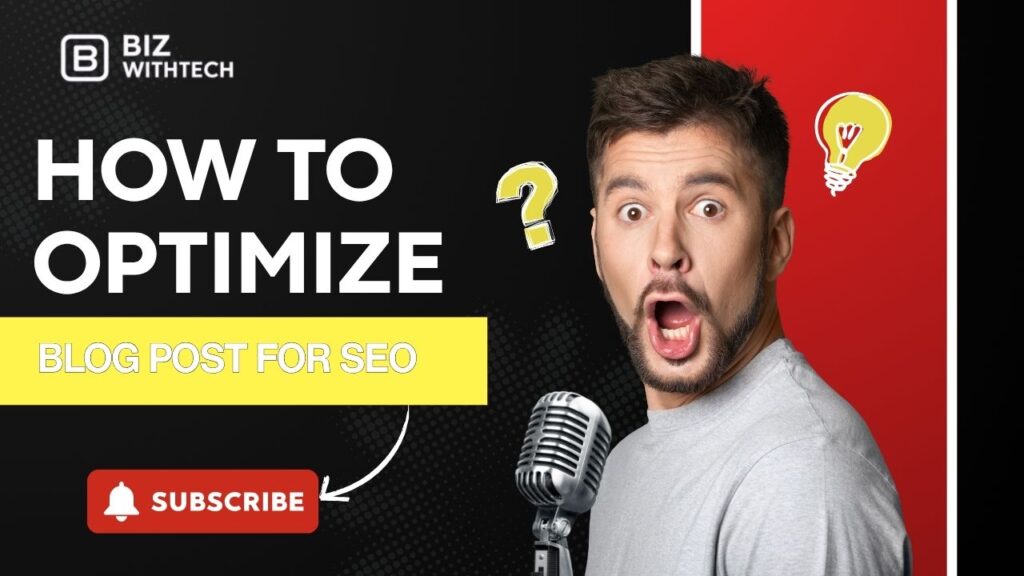Search Engine Optimization (SEO) can feel overwhelming, but it doesn’t have to be. Whether you’re a seasoned blogger or just starting out, understanding how to optimize your blog posts can dramatically increase your organic traffic and help your content reach the right audience. This comprehensive guide will walk you through every essential step to create SEO-friendly blog posts that rank well in search engines.
Understanding SEO Fundamentals:
Before diving into optimization tactics, it’s important to understand what SEO actually means. SEO is the practice of improving your content so search engines like Google can easily understand, index, and rank it for relevant search queries. When done correctly, SEO helps your ideal readers find your content when they’re actively searching for information you provide.
The goal isn’t to trick search engines or stuff your content with keywords. Modern SEO is about creating high-quality, valuable content that genuinely serves your audience while following best practices that make it easy for search engines to discover and recommend your work.
Keyword Research: The Foundation of SEO:
Every successful blog post starts with solid keyword research. Keywords are the phrases and terms people type into search engines when looking for information. Your job is to identify which keywords your target audience is using and create content around those terms.
How to Find the Right Keywords?
Start by brainstorming topics relevant to your niche and audience. Think about the questions your readers ask, the problems they need solved, and the information they seek. Once you have a list of potential topics, use keyword research tools to analyze search volume, competition, and related terms.
Look for keywords with decent search volume but reasonable competition. Long-tail keywords (phrases with three or more words) are often easier to rank for than single-word terms. For example, “how to optimize blog posts for SEO” is a long-tail keyword that’s more specific and typically less competitive than just “SEO.”
Understanding Search Intent
Not all keywords are created equal. Understanding search intent means recognizing what users actually want when they search for a particular term. There are four main types of search intent:
Informational intent is when users want to learn something or find an answer to a question. These searches often include words like “how to,” “what is,” or “guide to.”
Navigational intent occurs when users are looking for a specific website or page. They might search for a brand name or specific product.
Transactional intent indicates users are ready to make a purchase or take a specific action. These searches often include words like “buy,” “discount,” or “deal.”
Commercial investigation happens when users are researching before making a purchase decision. They might search for “best,” “top,” or “review.”
Align your content with the search intent behind your target keywords. If someone searches “how to optimize blog posts,” they want a guide, not a sales pitch for SEO services.
Crafting SEO-Friendly Titles
Your blog post title is one of the most critical SEO elements. It’s the first thing both search engines and potential readers see, and it significantly impacts click-through rates.
Title Optimization Best Practices
Include your primary keyword near the beginning of your title when possible. This helps search engines quickly understand what your content is about. However, don’t sacrifice readability for keyword placement. Your title should still sound natural and compelling to human readers.
Keep your titles between 50-60 characters to ensure they display fully in search results. Titles that get cut off with an ellipsis may get fewer clicks because readers can’t see the complete message.
Make your titles compelling and promise value. Use power words, numbers, and specific promises that make readers want to click. Compare “SEO Tips” to “How To Optimize A Blog Post For SEO: 15 Proven Strategies That Work” – the second is far more enticing and specific.
Writing SEO-Optimized Content
Once you’ve nailed your title, it’s time to focus on the body content. Great SEO content strikes a balance between serving your readers and following search engine best practices.
1. Content Structure and Length
Longer, comprehensive content tends to rank better in search results. While there’s no magic number, aim for at least 1,500-2,000 words for competitive topics. That said, length should serve a purpose. Every paragraph should add value, answer questions, or provide useful information.
Break your content into logical sections with clear headings and subheadings. This makes your post easier to read and helps search engines understand your content structure. Use H2 tags for main sections, H3 tags for subsections, and so on.
2. Strategic Keyword Usage
Include your primary keyword naturally throughout your content, but avoid keyword stuffing. Search engines are sophisticated enough to understand context and synonyms, so focus on writing naturally rather than forcing keywords into every sentence.
Place your primary keyword in important locations including your introduction (ideally within the first 100 words), several headings, naturally throughout the body content, and in your conclusion. Also use related keywords and synonyms to help search engines understand the full context of your topic.
The First Paragraph Matters
Your introduction serves multiple purposes for SEO. It needs to hook readers immediately, include your primary keyword, and clearly indicate what the post will cover. Search engines pay special attention to the beginning of your content, so make those first 100-150 words count.
Optimizing Meta Descriptions
The meta description is the short snippet that appears below your title in search results. While it doesn’t directly impact rankings, it significantly affects click-through rates, which can indirectly boost your SEO performance.
Write compelling meta descriptions between 150-160 characters that include your target keyword and clearly communicate the value of clicking through to your content. Think of it as advertising copy – you have just a few words to convince someone to choose your result over the others.
Make your meta description unique for every post. Don’t just copy the first sentence of your article. Instead, craft a specific summary that makes readers want to learn more.
URL Structure Optimization:
Your URL (also called a permalink) is another important SEO signal. Clean, descriptive URLs help both search engines and users understand what your page is about before even clicking.
Best Practices for URLs
Keep URLs short, simple, and descriptive. Include your primary keyword when possible, but keep it natural. Remove unnecessary words like “a,” “the,” “and” when they don’t add meaning.
Use hyphens to separate words, not underscores or spaces. Lowercase letters are standard practice and help avoid potential duplicate content issues.
For example, instead of “yoursite.com/2024/10/16/post-12345/how-to-optimize-a-blog-post-for-search-engine-optimization-complete-guide,” use “yoursite.com/optimize-blog-post-seo”
The Power of Internal and External Links
Linking is a crucial but often overlooked aspect of SEO optimization. Both internal links (to other pages on your site) and external links (to other websites) serve important purposes.
Internal Linking Strategy:
Internal links help search engines discover and understand the relationship between your content. They also keep readers on your site longer by guiding them to related articles.
Link to relevant posts using descriptive anchor text (the clickable text). Instead of “click here,” use specific phrases like “learn more about keyword research” that tell both readers and search engines what they’ll find on the other end.
Aim for 2-5 internal links per blog post, depending on length. Make sure the links add genuine value and aren’t forced.
External Linking:
External links to authoritative, relevant sources signal to search engines that you’ve done your research and your content is trustworthy. Don’t be afraid to link out to high-quality sources that support your points or provide additional value to readers.
Link to reputable websites with high domain authority. Make sure the sites you link to are relevant to your topic and trustworthy. Opening external links in new tabs can help keep readers on your site.
Image Optimization for SEO
Images make your content more engaging and easier to scan, but they also present SEO opportunities that many bloggers miss.
1. Optimizing Image Files
Before uploading images, compress them to reduce file size without sacrificing quality. Large image files slow down page load speed, which hurts both user experience and SEO rankings. Tools like TinyPNG or built-in compression features in image editing software can help.
Use descriptive file names that include relevant keywords. Instead of “IMG_1234.jpg,” use “blog-post-seo-optimization-tips.jpg”
2. Alt Text Optimization
Alt text (alternative text) describes your images to search engines and helps with accessibility for visually impaired readers using screen readers. Write clear, descriptive alt text that explains what’s in the image and includes relevant keywords when natural.
For example: “Screenshot showing keyword research tool with search volume data” is better than just “screenshot” or “keyword research.”
3. Mobile Optimization
With more than half of web traffic coming from mobile devices, mobile optimization is no longer optional. Google uses mobile-first indexing, meaning it primarily uses the mobile version of your content for ranking purposes.
Ensure your blog uses a responsive design that adapts to different screen sizes. Test your posts on various devices to make sure they’re readable and functional. Pay attention to font sizes, button sizes, and spacing that work well on smaller screens.
Page Speed Optimization
Page load speed is a confirmed Google ranking factor, and it dramatically impacts user experience. If your blog post takes too long to load, visitors will leave before even reading your carefully optimized content.
1. Improving Load Times
Compress and optimize all images before uploading. Use lazy loading so images only load as users scroll down the page. Minimize CSS and JavaScript files, and consider using a content delivery network (CDN) to serve your content faster to users around the world.
Enable browser caching so returning visitors don’t have to reload all your resources each time. Choose reliable, fast web hosting that can handle your traffic without slowdowns.
Use tools like Google PageSpeed Insights or GTmetrix to identify specific issues slowing down your site and get recommendations for improvements.
2. Schema Markup and Rich Snippets
Schema markup is code you add to your website that helps search engines understand your content better and display it more attractively in search results. Rich snippets can include star ratings, images, cooking times, or other information that makes your listing stand out.
While implementing schema markup is more technical, many WordPress plugins and website builders make it easier. Common schema types for blogs include Article, HowTo, FAQ, and Review schema.
3. Content Freshness and Updates
Search engines favor fresh, up-to-date content. Once you publish a blog post, your SEO work isn’t necessarily done. Regularly updating your content can help maintain or improve rankings over time.
Set a schedule to review your top-performing posts every 6-12 months. Update statistics, add new information, remove outdated references, and ensure all links still work. When you make significant updates, change the publication date to signal freshness to search engines.
👉 Want to learn step-by-step? Watch our video for a complete visual guide to optimizing your blog for SEO.
🎥 It’s the perfect companion to this article and will make implementing these tips even easier!
Promoting Readability
SEO isn’t just about search engines – it’s ultimately about creating content that serves human readers. Search engines are increasingly sophisticated at recognizing well-written, valuable content that keeps readers engaged.
1. Readability Best Practices
Use short paragraphs (2-4 sentences typically) to make content easier to scan. Vary your sentence length to maintain rhythm and interest. Include subheadings every few paragraphs to break up content and help readers find specific information.
Use bullet points and numbered lists to present information clearly. Add relevant images, screenshots, or graphics to illustrate concepts and break up text. Write in a conversational tone that sounds natural rather than stiff or overly formal.
Avoid jargon unless you’re writing for a technical audience that expects it. When you must use specialized terms, explain them clearly.
2. Building Engagement Signals
User engagement metrics like time on page, bounce rate, and pages per session can indirectly impact your SEO. Search engines interpret high engagement as a signal that your content is valuable and relevant.
End your posts with clear calls-to-action that encourage engagement. This might be asking readers to leave a comment, share the post, subscribe to your newsletter, or read related articles. Make it easy for satisfied readers to engage further with your content and brand.
The Role of Social Sharing
While social signals aren’t a direct ranking factor, social media promotion can indirectly benefit your SEO by increasing visibility, generating traffic, and potentially earning backlinks when other websites discover and reference your content.
Include social sharing buttons on your blog posts to make sharing effortless. Create compelling social media posts that encourage your followers to read and share your content. Engage with people who share or comment on your posts to build relationships and increase visibility.
Monitoring and Measuring SEO Success
SEO optimization is an ongoing process, not a one-time task. Regularly monitor your performance to understand what’s working and where you can improve.
Key Metrics to Track
Use Google Analytics to monitor organic traffic, bounce rate, time on page, and pages per session. Google Search Console shows which keywords are driving traffic, your average position in search results, and click-through rates.
Track keyword rankings over time to see if your optimization efforts are paying off. Monitor which posts are earning backlinks from other websites, as this is a strong ranking signal.
Pay attention to conversion metrics too. It’s not just about traffic – it’s about attracting the right visitors who take desired actions on your site.
Common SEO Mistakes to Avoid
Even with the best intentions, it’s easy to make mistakes that can hurt your SEO efforts.
Avoid keyword stuffing, which makes content awkward to read and can result in penalties. Don’t neglect mobile optimization or page speed. Resist the temptation to copy content from other sites – duplicate content can severely hurt your rankings.
Don’t ignore user experience in favor of SEO tactics. The best SEO strategy is one that serves your readers first. Avoid buying backlinks or participating in link schemes, which violate search engine guidelines and can result in penalties.
Don’t forget about technical SEO basics like having an XML sitemap, using HTTPS, and ensuring your site is crawlable by search engines.
Conclusion: Creating a Sustainable SEO Strategy
Optimizing a blog post for SEO requires attention to many details, but don’t let the complexity overwhelm you. Start by mastering the fundamentals: solid keyword research, compelling titles, well-structured content, and proper technical optimization.
Remember that SEO is a long-term game. You won’t see results overnight, but consistent effort following these best practices will gradually improve your rankings and organic traffic. Focus on creating genuinely valuable content for your target audience, then optimize it using the techniques outlined in this guide.
As you implement these strategies, track your results and refine your approach based on what works for your specific audience and niche. SEO best practices evolve, so stay informed about updates and changes while maintaining your focus on serving your readers first and foremost.
The most successful bloggers understand that SEO and great content aren’t opposing forces – they work together to help the right readers find your valuable content at exactly the right moment. By optimizing your blog posts thoughtfully and consistently, you’ll build a foundation for sustainable organic growth that can transform your blog’s reach and impact.




